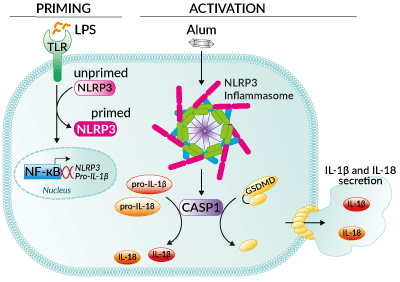Alum
| Product | Unit size | Cat. code | Docs. | Qty. | Price | |
|---|---|---|---|---|---|---|
|
Alum Hydroxide Aluminum hydroxide; ready‑to‑use suspension |
Show product |
500 µl |
tlrl-aloh
|
|

Inflammasome activation with Alum
NLRP3 Inflammasome Inducer - Alum
Aluminum hydroxide (also referred to as alum), are commonly used vaccine adjuvants, although their mode of action in vivo remains unclear.
Comprehensive research in vitro demonstrates that alum induces an NLRP3 inflammasome-dependent induction of interleukin-1β (IL-1β) and IL-18 [1].
InvivoGen provides Alum as a ready‑to‑use suspension. Its biological activity has been validated using THP1-Null cells. Of note, Alum hydroxide induces significantly higher levels of IL-1β by THP1-Null cells than Alum crystals, using the HEK-Blue™ IL-1β cellular assay.
 InvivoGen also offers:
InvivoGen also offers:
• HEK-Blue™ IL-1β: IL-1β Sensor Cells
• THP1-HMGB1-Lucia™: Pyroptosis Reporter Cells
Key features:
- Inducer of the NLRP3 inflammasome
- Each lot is functionally tested
![]() Read our review on the NLRP3 inflammasome.
Read our review on the NLRP3 inflammasome.
![]() Download our Practical guide on Inflammasomes.
Download our Practical guide on Inflammasomes.
Reference:
1. Li H. et al., 2008. Cutting Edge: Inflammasome activation by Alum and Alum’s adjuvant effect are mediated by NLRP3. J Immunol. 181:17-21.
Back to the topSpecifications
CAS number: 21645-51-2
Working concentrations: 50 - 500 µg/ml
Chemical formula: Al(OH)3
Molecular weight: 78 g/mol
Form: Liquid (a ready-to-use suspension)
Quality control:
- The biological activity has been validated using cellular assays.
- The absence of bacterial contamination (e.g. lipoproteins and endotoxins) has been confirmed using HEK-Blue™ TLR2 and HEK-Blue™ TLR4 cells.
Contents
- 500 µl of Alum Hydroxide (aluminium hydroxide suspension) provided as a white suspension at 30 mg/ml.
![]() Product is shipped at room temperature
Product is shipped at room temperature
![]() Store at room temperature. DO NOT FREEZE.
Store at room temperature. DO NOT FREEZE.
Details
Aluminum salts (also referred to as alum), such as aluminum hydroxide, aluminum phosphate, or potassium aluminum sulfate, are commonly used vaccine adjuvants, although their mode of action in vivo remains unclear [1]. Alum has been shown to trigger NLRP3 activation through lysosomal destabilization [2]. Interestingly, in vivo studies indicate a minimal role for the NLRP3 inflammasome in alum’s adjuvanticity [3]. The reason for this divergence between the in vitro and in vivo action of alum needs to be further investigated.
The NLRP3 inflammasome is an intracellular multi-protein complex that plays a central role in innate immunity. It is activated by a two-step process. A first signal (‘priming’) is provided by pathogen-associated molecular patterns (PAMPs) or cytokines. It allows the transcriptional upregulation of key inflammasome actors and the post-translational modification of NLRP3 . The second signal (‘activation’) is provided by a wide array of stimuli including microbial toxins, endogenous molecules or crystalline substances. The current paradigm is that NLRP3 does not bind directly to these molecules. Rather it senses downstream cytosolic stress signals such as K+ efflux. This triggers inflammasome multimerization and pro-caspase-1 maturation. Proximity-induced autolytic activation of caspase-1 leads to the formation of gasdermin D (GSDMD) pores at the cell surface, allowing IL-1β/IL-18 and alarmin secretion, and ultimately, pyroptosis [4,5].
References:
1. Li H. et al., 2008. Cutting Edge: Inflammasome activation by Alum and Alum’s adjuvant effect are mediated by NLRP3. J Immunol. 181:17-21.
2. Hornung V. et al., 2008. Silica crystals and aluminium salts activate the NALP3 inflammasome through phagosomal destabilization. Nature Immunol. 9:847-856.
3. Wen Y. & Shi Y., 2016. Alum: an old dog with new tricks. Emerg Microbes Infect.5:e25.
4. Swanson K.V. et al., 2019. The NLRP3 inflammasome: molecular activation and regulation to therapeutics. Nat. Rev. Immunol. 19:477.
5. Groslambert M. & Py B. 2018. Spotlight on the NLRP3 inflammasome pathway. J. Inflamm. Res. 11:359.
Back to the top








